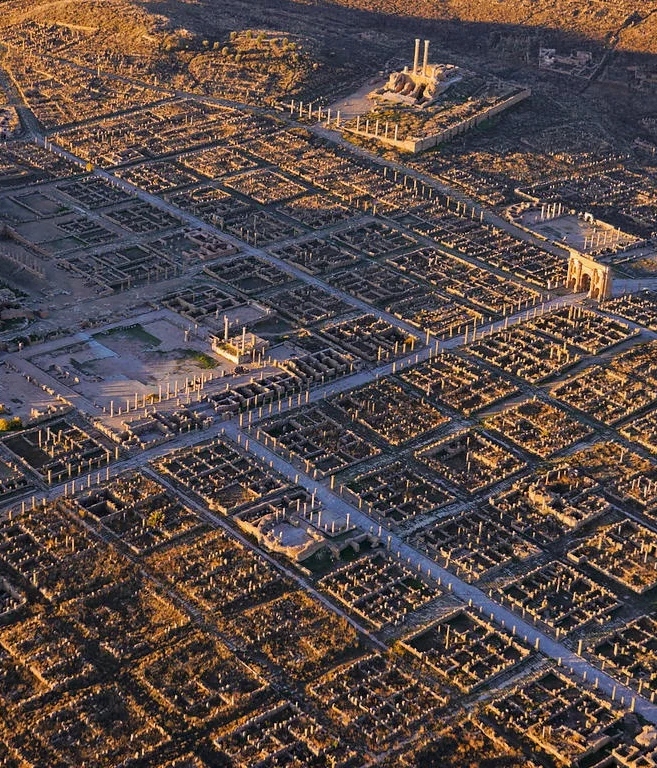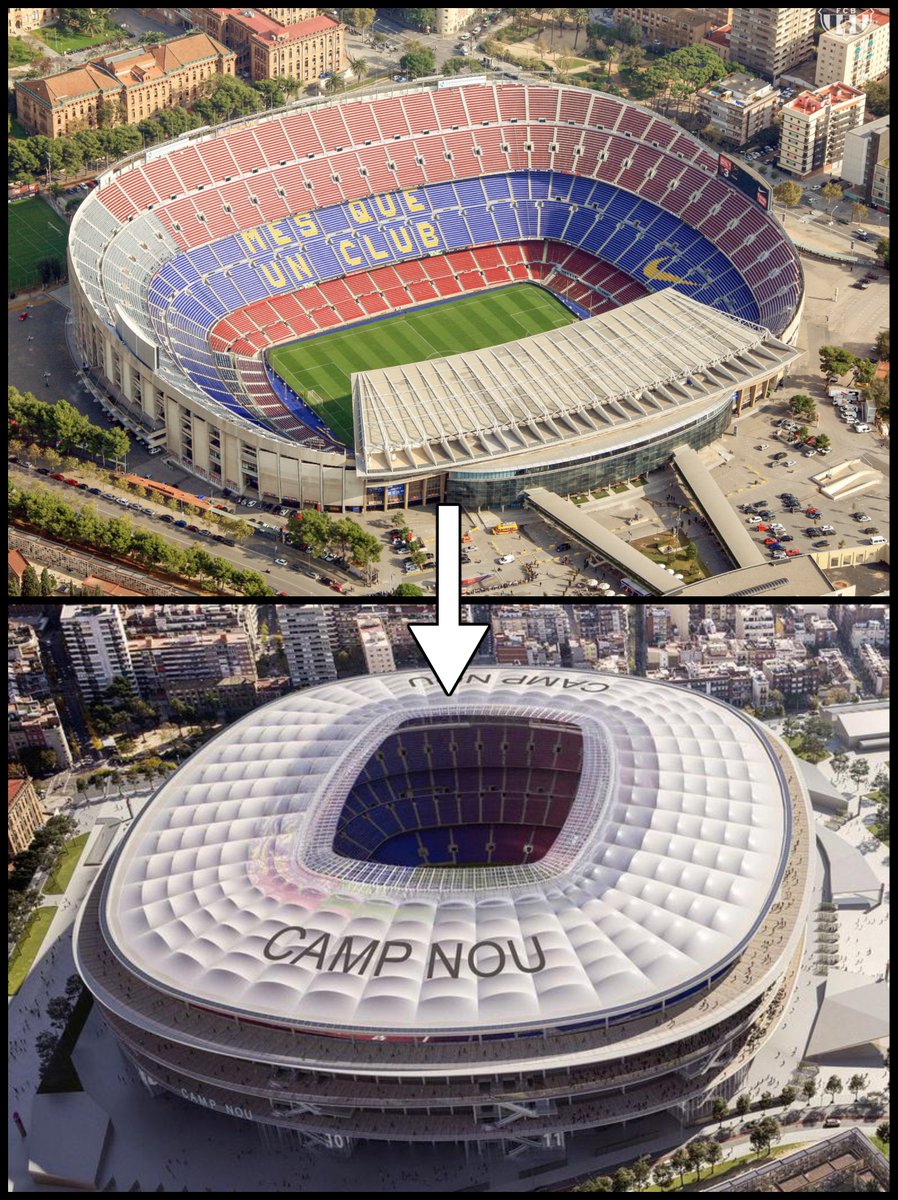This is the city of Timgad in Algeria, built by the Romans nearly 2,000 years ago.
Though the grid plan might seem like a modern invention, it's ancient.
From the Aztecs to the Egyptians, from Greece to China to the USA, here's why your city is (probably) built as a grid...
Though the grid plan might seem like a modern invention, it's ancient.
From the Aztecs to the Egyptians, from Greece to China to the USA, here's why your city is (probably) built as a grid...

What do you picture when you imagine an "old" city?
Perhaps something like this — a labyrinth of streets in all shapes and sizes, some narrow and winding, others broad and majestic. Odd angles, dead ends, plazas, alleys... no apparent logic.
A jungle of organic urban growth.
Perhaps something like this — a labyrinth of streets in all shapes and sizes, some narrow and winding, others broad and majestic. Odd angles, dead ends, plazas, alleys... no apparent logic.
A jungle of organic urban growth.

Well, here's what the city of Babylon looked like, according to the Ancient Greek historian Herodotus — a clear and ordered urban plan in the shape of a square, organised on a grid.
His description may have been fanciful, but many ancient cities really did look like this.
His description may have been fanciful, but many ancient cities really did look like this.

The same is true of all ancient civilisations, right across the world, from the Indus Valley to Mesopotamia and Egypt to South America.
Whenever we build an ordered city, whether four thousand years ago or today, a grid is what we go for.
Whenever we build an ordered city, whether four thousand years ago or today, a grid is what we go for.

When the Yongle Emperor of China made Beijing his capital in the early 1400s he had it designed according to the Kao Gong Ji, a sort of encyclopaedia written in the 4th century BC.
It describes the ideal city as a square with streets laid out at right-angles to one another.
It describes the ideal city as a square with streets laid out at right-angles to one another.

The first urban planner whose name we know was a Greek called Hippodamus, who lived and worked in the 5th century BC.
His major projects included the design or reconstruction of cities like Piraeus, Rhodes, and Miletus.
Hippodamus built them all on a grid of rectangular blocks.
His major projects included the design or reconstruction of cities like Piraeus, Rhodes, and Miletus.
Hippodamus built them all on a grid of rectangular blocks.

Hippodamus' principles — inherited from Mesopotamia, seemingly — were applied right across the ancient world for centuries.
After Alexander the Great founded Alexandria in Egypt it was laid out by the architect Dinocrates according to the Hippodamian plan.
After Alexander the Great founded Alexandria in Egypt it was laid out by the architect Dinocrates according to the Hippodamian plan.

These ideas were then inherited by the Romans.
A Roman architect called Vitruvius, who wrote the only surviving architectural treatise from the ancient world, describes the ideal layout of a city.
Once again... a grid. Perfectly ordered and rational.
A Roman architect called Vitruvius, who wrote the only surviving architectural treatise from the ancient world, describes the ideal layout of a city.
Once again... a grid. Perfectly ordered and rational.

Such rigorous urban planning may have disappeared in Europe, to be replaced by disorderly Medieval towns, but the grid remained a fixture of cities around the world — Kyoto in Japan is but one example.
And, of course, the Hippodamian plan made a soaring comeback in the 1700s...
And, of course, the Hippodamian plan made a soaring comeback in the 1700s...

Edinburgh's New Town, built in the late 18th century, is a fine example of the return of grids.
This startlingly rational urban design made for a stark contrast with the city's winding Medieval quarters.
This startlingly rational urban design made for a stark contrast with the city's winding Medieval quarters.

But it was in the USA where grids were used most widely for the design of new towns and cities, whether New York or Philadelphia.
Grids which have endured to this day and now define the cities of America, as opposed to the disordered cities in older parts of the world.
Grids which have endured to this day and now define the cities of America, as opposed to the disordered cities in older parts of the world.

What do all these grid plans have in common, ancient or modern?
They were created either when a city was newly founded or an old city underwent large-scale reconstruction or expansion.
Timgad in Algeria, a perfect example of Roman urban planning, was founded in 100 AD.
They were created either when a city was newly founded or an old city underwent large-scale reconstruction or expansion.
Timgad in Algeria, a perfect example of Roman urban planning, was founded in 100 AD.

In the 19th century Barcelona demolished its Medieval walls and, through a vast construction project known as the Eixample, spread out and connected to six surrounding towns.
All that space was filled with Ildefons Cerdà's famous grid of chamfered blocks.
All that space was filled with Ildefons Cerdà's famous grid of chamfered blocks.

After the Great Fire of London in 1666 initial proposals for rebuilding involved a grid.
This didn't happen, for various interesting reasons, but the point is that such a vast and regulated plan was only made possible by the opportunity for reconstruction.
This didn't happen, for various interesting reasons, but the point is that such a vast and regulated plan was only made possible by the opportunity for reconstruction.

The grid, whether in Ancient Mesopotamia or China, in Kyoto or Mohenjo-daro, Manhattan or Edinburgh, is always a consequence of top-down urban planning.
It is the result of a blueprint, of the plan of a committee or individual with the power to impose it.
It is the result of a blueprint, of the plan of a committee or individual with the power to impose it.
Which explains why the city of Rome itself, which had grown slowly over centuries, was not on a grid plan typical of new Roman towns.
There was plenty of demolition and reconstruction, but at no point was a single person's vision — which usually ends up as a grid — imposed.
There was plenty of demolition and reconstruction, but at no point was a single person's vision — which usually ends up as a grid — imposed.

Unlike, say, the Roman colony which became modern-day Cologne, in Germany.
Why has the grid appealed to urban planners for millennia? In short, because it makes sense. Everything has its place and everything is much easier to manage.
Order, rather than chaos.
Why has the grid appealed to urban planners for millennia? In short, because it makes sense. Everything has its place and everything is much easier to manage.
Order, rather than chaos.

After all, if somebody set out to build a city from scratch, they would never propose something like this.
Or, in reverse, people working without an overall plan would never produce a grid.
Or, in reverse, people working without an overall plan would never produce a grid.

Such cities only arise where growth and construction are piecemeal and spontaneous, where each new generation meddles with it, where there is never a central authority with enough power to redesign and rebuild everything.
You can't plan the unplannable.
You can't plan the unplannable.

But the great benefit of top-down planning is also its greatest curse.
A single error in the underlying concepts of a blueprint can ruin a city forever, and it gives individuals huge power to control life in the city.
As Aristotle noted when writing about Hippodamus.
A single error in the underlying concepts of a blueprint can ruin a city forever, and it gives individuals huge power to control life in the city.
As Aristotle noted when writing about Hippodamus.

To plan a city from scratch necessarily involves decisions about who lives where and how life in the city will function.
And so beyond dictating how people must live, such plans have often resulted in segregation, intentional or otherwise.
And so beyond dictating how people must live, such plans have often resulted in segregation, intentional or otherwise.

These problems are not exclusive to top-down urban plans, but the danger is more acute. Still, though some have been miserable failures, others have been a lasting success.
Such are the stories streets tell: order and chaos, progress and inheritance, power and people.
Such are the stories streets tell: order and chaos, progress and inheritance, power and people.

So grid plans in cities are older — way older — than we might think. They represent humanity's ancient and enduring instinct for imposing order on the world.
But grid plans are necessarily imposed from above; they also represent the exercise of authority and control...
But grid plans are necessarily imposed from above; they also represent the exercise of authority and control...
• • •
Missing some Tweet in this thread? You can try to
force a refresh






















